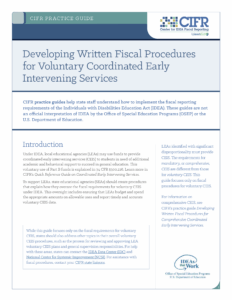Improving state capacity to collect, report, analyze, and use IDEA fiscal data

What can we help you find today?
or Request TA
What States Are Saying
As we were developing our grant application and budget, CIFR showed us that we needed a process. We created guidance, templates, and instructions. It was a breeze this year compared to last.
Featured Resources
Part C
Using IDEA Part C Funds: How the First In, First Out Method Works
This guide explains the “first in, first out” method to help states use IDEA Part C funds before they expire.
IDEA Part C Maintenance of Effort Calculator
This Excel calculator helps lead agencies identify funding sources, track budgets and expenditures, account for allowances, and determine MOE compliance for up to five years.
Part B
Developing Written Fiscal Procedures for Voluntary Coordinated Early Intervening Services
This guide helps states create or improve procedures for managing IDEA Part B fiscal requirements for voluntary CEIS, providing sample language and guiding questions for key components.
IDEA Part B State Set-Aside Calculator: Section 611
Plan state set-aside budgets, complete OSEP spreadsheets, and track expenditures using this Excel-based tool.




